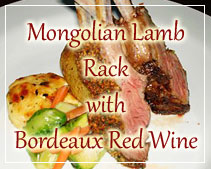Low Fat Cuisines
june 6.2011
Many ethnic and specialty restaurants offer exquisite tasting cuisines that feature whole grains, legumes, vegetables and fruits and recipes supplemented with fish or poultry .
Any low fat cuisine that’s new to you can tempt or challenge your taste buds and if you go for meatless fare, you’ll get low fat along with high flavor.
Here are several insights about a number of our favorite low fat cuisines.
Italian Cuisine
Delicious low fat foods with a pleasing array of tastes make Italian restaurants a good choice for dining away from home. Pasta with marinara (tomato based), vegetable, red clam or wine sauce is firs rate. Shrimp al vino blanco (sautéed in white wine) gets high marks, too, for its low fat content.
If you see polio cacciatore on the menu, it’s another good option boneless chicken breast served in a tomato and mushroom sauce. The list also includes non meat (vegetable) lasagna, but you need to ask for low fat cheeses or less cheese. Or try cioppino fisherman’s stew with a variety of seafood and vegetables in a tomato based stock if you first make certain the stock is low in fat.
Enjoy pizza? Hold the olives, and ask for extra vegetables but one half or one third the normal amount of cheese. Onions, green peppers and mushrooms are good low fat toppings, but you’ll also want to try fresh spinach, garlic, tomatoes, artichoke hearts, beans, seafood, skinless turkey or chicken breast and other ingredients for an inviting change of pace.
Mexican Cuisine
When chosen with care, Mexican food is inexpensive, delicious, high in complex carbohydrates arid low in fat. Beans, rice, unfried corn tortillas, salsa, fish and salads are common staples. Vegetable bean burritos, fresh fish marinated in lime sauce and beans with rice are low fat specialties.
Some authentic Mexican recipes include distinctive vegetables with unique flavors. JIcama is a tropical fruit that looks similar to a rutabaga and tastes delicious. Occasionally, squash blossoms are served as a garnish. Whenever you have the opportunity, try tomatillos (similar to small, naturally green tomatoes), chayote (a pear-shaped squash) and nopal cactus.
And of course, Mexico is famous for its dehghtful array of fresh peppers. A good practice when selecting a new Mexican stile restaurant is to call ahead and ask if the chef uses lard, coconut oil or another oil in the refried beans. Many eateries have switched to small amounts of soybean oil or, ideally, add no fat at all. Skip the sour cream, guacamole, red meat, pork and egg dishes as well as fried foods, and request no more than half the usual amount of cheese.
French Cuisine
Each region of France can be recognized by its distinctive culinary riches. In recent years, food from the warm and sunny south of France grilled seafood, vegetables, garlic and spices, cooked or served with splashes of olive oil has become popular in America.
More French chefs than ever before are preparing nouvelle cuisine, including a special variety called cuisine minceur (‘’cuisine of slimness”). To create these low-fat specialties that preserve the French touch, chefs use culinary techniques such as steaming or poaching seafood or poultry in vegetable juices and wine and serving side dishes of fresh vegetables, potatoes and grains.
When you’re offered dessert in a French restaurant, skip the tempting pastries and request fresh fruit. While it may seem hard to ignore the pastry tray, your meal will end on a wonderful high note if you choose poached fruit (usually peaches or pears). It’s cooked in a light wine sauce, which adds a delightful flavor with few calories.
Spanish Cuisine
A variety of culinary specialties from Spain emphasize beans, rice, fresh seafood or poultry, potatoes, peppers, garlic and fresh vegetables, with the flavor of olive oil that characterizes so much Mediterranean cooking. Spanish appetizers called tapcis have gained popularity in America.
Traditionally, these snacks include a wide range of hot and cold morsels such as seafood, vegetables, olives and salads served as midday and early evening appetizers on large platters. Just be sure to bypass the egg dishes, fried foods and dishes that are loaded with sausage and other meats.
Indian Cuisine
Recipes used in many Indian restaurants often include vegetables, legumes, yogurt and lots of spices. Avoid dishes soaked in coconut oil or ghee, which is clarified butter. One popular recipe is murgjalfraize chicken or legumes flavored with fresh spices and sautéed with onions, tomatoes and bell peppers. For the lowest fat version of this dish, ask that it be sautéed without butter or oil.
Chinese Cuisine
Some menu items at Chinese restaurants are good choices because of the emphasis on rice and vegetables, with only small amounts of seafood or poultry. Bypass the appetizer dishes such as egg rolls and spring rolls, they’re usually deep fried and just brimming with fat. And whatever you do, avoid duck: Just 3½ ounces of Peking duck has 30 grams of fat.
Stir fried dishes generally get good low-fat ratings. They tend to be cooked quickly in a lightly oiled, very hot wok, and the vegetables retain more vitamins than those cooked the traditional American way. Also, the oil is usually peanut, which is high in monounsaturated but always ask that the chef use as little oil as possible. One favorite low-fat stir-fry is moo goo gai pan, a combination of mushrooms, bamboo shoots, water chestnuts and chicken, seafood or tofu served over rice.
Japanese Cuisine
Generally low in fat, Japanese cuisine is based on protein rich soybean products such as tofu and tempeh as well as on seafood, vegetables, noodles and rice. The seaweed used in Japanese soups and stews is high in minerals. One top entrée choice is yosenabe, a vegetable dish with seafood.
American Cuisine
Once you get away from American fast-food places and into some regional and specialty restaurants, you find healthful dishes and an array of dining options. Many restaurants in New England and on the West Coast have unbeatable selections of their own fresh seafood specials, served with salads that feature fresh vegetables and greens from nearby farms.
Cajun restaurants are sprouting up all over but beware the deep fried food. Instead, order Cajun gumbos and other redhot dishes; you’ll get new flavors that quell your appetite while challenging your taste buds. Restaurants that feature California cuisine low fat dishes with lots of fresh vegetables and beans are also cropping up nationwide. Serving sizes are reasonable, and many cooks areexploring wonderful new ways to bring out the best flavors in fresh foods and legumes.
Source: http://curepages.com/low-fat-cuisines/











